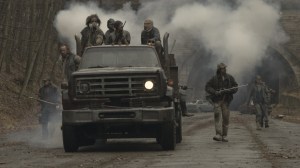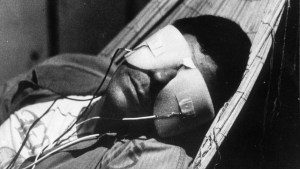Star Trek: Strange New Worlds returns to Paramount+ on Thursday, offering Star Trek fans more of what they loved about the first season. That’s according to Star Trek: Strange New Worlds co-showrunners Henry Alonso Myers and Akiva Goldsman, who took some time to talk with ComicBook.com about the second season of the highly-acclaimed Star Trek: Discovery spinoff. which brings back the cast of the first season minus the deceased ship’s engineer Hemmer (Bruce Horak). Carol Kane’s Pelia takes over as Enterpirse’s new Chief Engineer, and we made sure to ask Myers and Goldsman whether the position will continue to have a high turnaround rate.
Videos by ComicBook.com
The new Star Trek: Strange New Worlds season also brings back Paul Wesley as Lt. James T. Kirk in a recurring role, which the showrunners touch on as well. Here’s everything they had to say ahead of the season premiere:

We get more of Paul Wesley’s Kirk in Star Trek: Strange New Worlds Season 2 and he’s more familiar than the slightly grimmer Kirk from an alternate universe we met in the first season’s finale. How would you describe Kirk’s role in Season 2?
Henry Alonso Myers: Well, we will see some alt-universe, and we will see something that is a little more recognizable, and for us, the huge fun of this is no one spent a lot of time talking about what the emotional life of Kirk was prior to before we meet him. That was really our opportunity to dig into it and imagine how he eventually became the person that he would be, but he isn’t there yet. We love Paul. He’s fantastic. He’s been really a joy to work with.
I’m going to run a pet idea of mine by you to get your thoughts. Star Trek: Picard Season 3 had that Easter egg where we learn that Kirk’s body is on ice. I’ve had the idea that there’s an opportunity for someone to resurrect and rejuvenate Kirk, and let Paul Wesley go play him in the 25th century. Is that a thought that’s crossed either of your minds at this point?
Akiva Goldsman: Well, it hasn’t until now.
Feel free to run with it. I give it to you freely.
AG: Thank you. Good idea.
Star Trek: Strange New Worlds Season 1 was a huge success. It became the highest-rated Star Trek series on . It was a big deal, and fans took to it immediately. Has the success of the first season changed anything about your approach to the second season? Are you allowed to take bigger risks? Have you incorporated any feedback you’ve gotten from fans or elsewhere? Or is it pretty much business as usual for you?
AG: Well, I think what’s interesting is, Henry always says, “It’s Season 1, just more, bigger, better.” And I think the answer to the question is sure, some. It helped us some, for sure, because we were doing a few things that are atypical. We were jumping around the genre, although if you’re a TOS fan and even, to some extent, if you know Next Gen, you see more of that but it’s not typical in television today. We were going back to episodic, and unlike Disco, we are an ensemble piece, but we don’t service the ensemble each episode. We pointedly choose a hero narrative eye and move through it. So it was a little wacky, or at least maybe it was for folks who weren’t us, and maybe we even thought it was a little wacky but believed in it. So what happens when it lands positively is it gives you permission to really do that. So as Henry says, we just are doing it more.
HAM: There was also some production stuff that was unique and new to us in Season 1 that we really just wanted to make sure that we knew how to make it work. Once we realized, “Okay, we’ve got it, we’re going to make it work,” let’s try to do it more challengingly, do things that we wouldn’t necessarily have been able to pull off Season 1. There are definitely a few of those. When you’re bigger and you have more strength to do it, you want to try it, because what’s the point of not giving it a go, and trying to make it as good and as interesting and as big and as crazy as you can possibly get?
Star Trek: Strange New Worlds is episodic, but there was an arc to Season 1, particularly with Pike dealing with his own mortality. Is there a connective tissue or throughline, either thematic or a particular arc, that you think connects all these episodes this season? Or is it possibly even more episodic than the first one?
HAM: Well, it was very important to us, and the same as the first season, to have each of the characters going on a journey, but you don’t necessarily have to know what that is and follow it super tightly in order to watch from episode to episode. Each episode is its own unique story, but the lives of these people are real and they have a place to go. We tried that in Season 1. It has this very Next Gen quality where one day we go on this person, one day we follow that person.
It was a great opportunity to have. We have this terrific cast and it’s a great opportunity to try to give everyone a chance to do something big and real, because you just get better performances from actors, and our actors are great. We’re so lucky to have every single one of them. And why would you not try to give everyone a moment, or a couple of moments, to really make it work for them? We knew that was working, and it’s a great way to give each individual episode that has its own flavor its own unique emotion at the core of it.
AG: And remember, you’ve seen the first half, which would typically be where the setups live. The second half would typically be where the payoffs live. By the time you finish the season, you will feel the same sort of character draft that has pulled you through, actually with maybe even a little more, because we’re probably trying, now realizing we can get away with it, to service that idea with more than one.
We have a new ship’s engineer this season with Carol Kane as Pelia. She’s bringing a very different energy than what we got from Bruce Horak as Hemmer last season. Why did you decide to go in that direction, which continues this trend I’ve noticed of funny women as engineers in sci-fi, with Tig Notaro, and over in The Mandalorian, you’ve got Amy Sedaris? Can you say how many generations we are away from Mr. Scott? Is this going to be a situation where there’s a new one every season?
AG: …
HAM: …
AG: Look how quiet we are. Aren’t we quiet?
Here’s what it’s not. It’s not Spinal Tap. We’re not killing an engineer every season. I mean, I pitched it, but we’re not.
HAM: The big thing was we zigged in one season, and we wanted to try to zag, which was like, how can we find a person who doesn’t feel like we’ve seen them before in Star Trek, and who might give us a unique and interesting perspective? We had a version of a character, and we were very lucky in that we were talking with our casting people and they were like, “What about Carol Kane for this?” And it suddenly snapped. And she, of course, brought her own unique and delightful perspective to it.
As a show, we probably are slightly more interested in making sure comedy is present than some of the other Trek shows, just because that’s part of what we have, and that’s something she happens to be very good at, so it was fun to be able to lean on her in that way. It’s important to us to have different genres that have different areas of emotion that we’re exploring, some of them funny, some of them scary, and that one speaks to a different kind that we didn’t get to see as much. We’re trying to give the show a unique and specific look and feel.
You mentioned a couple of times that you’re exploring different genres in different episodes. One genre I noticed comes up a lot, or at least it is a kind of mode that’s present across episodes, is romance. There’s a lot of it compared to other Star Trek shows — Disco has some, but it hasn’t been a huge focus for Star Trek, but there are some very romantic, relationship-focused episodes here. Was that the intent, or did you get taken in that direction unexpectedly?
AG: Well, I think that we are trying to tell real emotional stories. That’s what we go for, especially because for those folks who know canon, not that that is in any way necessary, but for those who do, the endings are written. So how do we make the beginnings and middles dynamic? And we do that by having people have real human or alien emotions so that they can connect to each other.
And there’s also seemingly a truth, which is if you’re on a ship in the middle of space for a really long time, and it’s life and death, you’re probably going to kiss someone. And so there’s kissing, and we like it. And we like the fact that people can have a real range of emotions. I mean, God knows people punch each other all the time in TV shows. They should be able to kiss each other too.
HAM: The other thing is that if you just look at some of those elements, they’re all things, in The Original Series, that they go into. Part of what we wanted to do was try to imagine the depth that lead them there. I mean, T’Pring is in the original show. Chapel-Spock is in the original show. We wanted to say, “Okay, so Chapel and Spock have this initial way of behaving toward each other in the original show. What if we ihave a chance to deepen that, imagine why it would be that way, where they came from? What would a modern audience expect from this that they wouldn’t necessarily expect from the original show? And let’s try that.”
You mentioned canon. That’s something where you work with it, you work around it, and sometimes you work through it.
HAM: Correct.
We get some significant first meetings this season. I won’t spoil what those are in this interview, but you build episodes for some of them and then some of them are surprisingly understated, the way handled them. What were the conversations like in the writer’s room about how to handle those moments, and have there been conversations about how to dole those moments out, so that they’re not all upfront, and there are other cool moments like that to look forward to in the future?
HAM: Well, we had an opportunity for a lot of these to show something that was familiar to people. But it was, again, not to come back to this a lot, but Akiva and I discuss this a ton, but we really want this to be a show that you don’t necessarily have to recognize to get something out of it. And I think that that actually, in a weird way, is almost a great freedom because it allows us to imagine a deeper, more complicated approach to relationships that they probably weren’t concerned about back in the ’60s, because they were making a different show at a different time with different ideas. That’s the opportunity that we got, and so we also don’t want to alienate people. We don’t want to make it so that you have to know everything in order to appreciate the show. We wanted to give a special gift to the people who know about it, but also give a scene that makes perfect sense to people who don’t.
AG: Henry is fond of saying, and I really agree, that the characters don’t know that their encounters are full of portent — because I know which moment you’re talking about — and so in fact, for them, it was, “Hey, hey,” right? They don’t know, and you want to keep your audience and your characters together. That’s your most successful narrative engine unless you’re on purpose putting them at a distance. And we like to do that. We like to have the experience of the characters and the experience of the audience be similar. So we don’t want to be winking at the audience at the expense of the character’s experience of the moment.
Star Trek: Strange New Worlds Season 2 Release Date
Star Trek: Strange New Worlds Season 2 premieres on Paramount+ in the United States, the U.K., Australia, Latin America, Brazil, France, Italy, Germany, Switzerland, and Austria on Thursday, June 15th. The second season will also be available to stream on Paramount+ in South Korea, with the premiere date to be announced later. New episodes of the 10-episode season will then debut weekly on Thursdays.
Star Trek: Strange New Worlds Season 1 is already streaming. It is also available as home media on Blu-ray, DVD, and 4k UHD.








